From plant inspiration to jewelry production, a look at the new Somnia ear weights
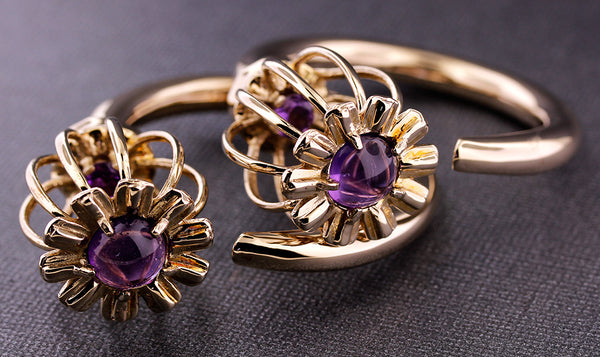
After my family, my two loves in life are making body jewelry and being around plants. When I make, progress is the name of the game. Between finishing what's pending in the queue and working on new styles, it gets a bit manic sometimes. When I am around plants, the opposite is true. Being a cultivator (of anything, but particularly of self and of plants) requires a great deal of submission and mindfulness. Standing back and being attentive is meditative - something I both require and enjoy. Consequently I spend a lot of my time thinking about, researching, and growing plants.
Studying ethnobotany, the human relationship with plants, is exciting for me in part because many of the cultures which initially discovered uses for the plants we know today were also body modifying cultures. This crossover in subject matter gives me a fantastic excuse to be a shameless nerd about two interests at the same time! A good example would be the peoples of Mesoamerica, a body modifying culture (stretched lobes, labret piercing, etc) who domesticated much of the common food known worldwide today. We have them to thank for our corn, peppers, tomatoes, potatoes, cacao, squash, and more. The history of where our food comes from, and how culturally important much of it was is humbling and enriching. We learn more about the roots of our cultural identity, and it makes it easier for us to connect with other people. In addition to food plants, early cultures worldwide also regularly made use of plants for medicine and ritual purposes. That list includes, among others, the opium poppy (Papaver) after which our new Somnia ear weight takes its form.

Poppy History
The poppy is a flower that has been known to humanity since before recorded history. Indications of poppy cultivation and use in the form of plant matter have been found throughout Europe and dated to as early as 4200BCE. Associated with both sleep and death, poppies and these themes appear in the mythology of most cultures who had access to it. The poppy flower was a friend to Hypnos, the Greek personification of sleep (Roman: Somnus), and poppies grew outside the entrance to his cave. One of the goddess Demeter's defining characteristics was her association with the poppy flower. Poppies are said to have originated from the tears of Aphrodite as she mourned the death of her lover Adonis.
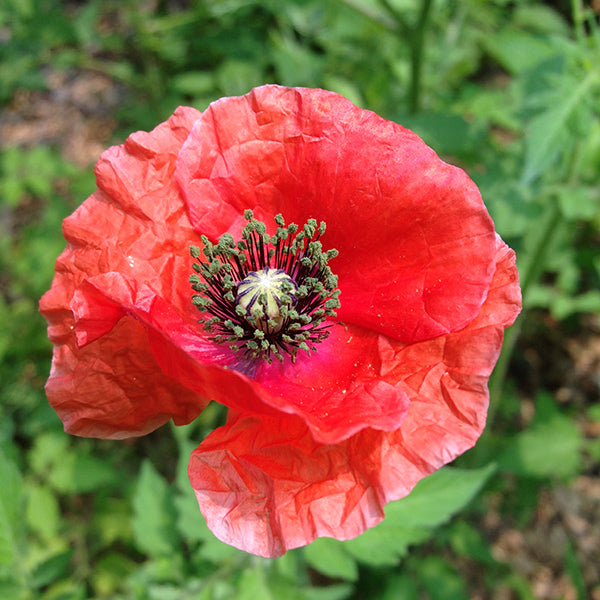
Poppy (Papaver spp.)
The sedative and painkilling effects of this sacred plant were well known very early in our history, and Sumerian, Egyptian, Greek, and other cultures utilized the opioids found within the fresh and dried pods via eating, drinking, and smoking them for the purposes of healing and divination. Greek physician Hippocrates promoted the use of opium juice for various ailments. The Chinese surgeon Hua To was prescribing an oral mixture of opium and Cannabis to his patients as a painkiller prior to surgical procedures around 200AD.
In the 1800's, poppy cultivation became a major cash crop, and the trade of opium related goods skyrocketed. The British, unhappy about their trade deficit with China (who had plenty to trade in the form of spices and other high value goods but needed nothing from the west) began smuggling Indian opium into China using the East India Company. As the importation of opium into China increased and addiction became a problem, the Chinese government tightened laws further, and then eventually seized and destroyed several huge shipments of it.
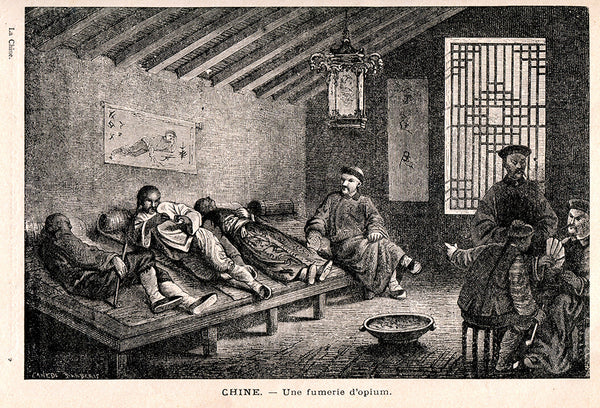
1800's Chinese opium den
The British retaliated and initiated what are now known today as the Opium Wars, using military aggression to force China to open more trade ports and continue importing massive amounts of opium. This ravaged the country, and today these acts remain some of the most terrible uses of a plant for political and economic control.
In 1805, German scientist Friedrich Sertürner isolated the first singular compound from a plant, and named it morphine, after the Greek god of dreams. In the 21st century, we know the poppy as both a beautiful ornamental flower and the original source for the medicinal compounds morphine, codeine, and the other opiates used in modern medicine.

Morphine Molecule
The evolution of the Somnia ear weights
Somnia started as a rough idea based on an old African style by the Tuareg tribe called a "Tsabit." The pair in my collection is one of my favorite pieces of jewelry because they are beautiful in form, but also because of the ingenuity of design.

These round hoops capped with chunky geometric designs come most of the way toward solving an interesting design problem - how to display something decorative from the ear and have it facing forward. Most of the original Tsabit pieces hang with the heaviest point facing downward, but I realized that with some clever placement of mass, the center of gravity could be moved and used to push a decorative element forward. Somnia's skeleton weighs less than the base of the pod, which creates a tendency for the skeleton to be pushed forward and show the gems, rather than hanging downward and obscuring the gems.
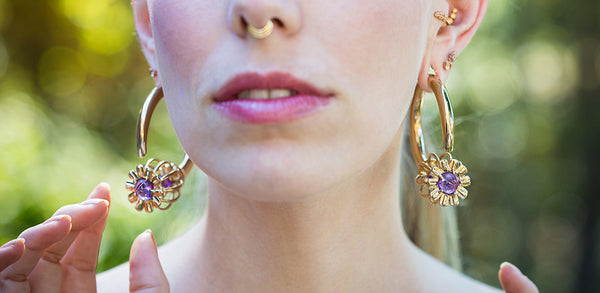
These pieces started as a series of simple drawings where the solid poppy pod and stem idea came to fruition. I loved the idea of a poppy pod hanging from it's hoop shaped stem. This concept eventually evolved to become the pod's skeleton and stem. This decision was partially out of visual interest, and partially as the result of troubleshooting on paper to estimate how the mass was going to hang.
From there I enlisted the help of a friend who worked with me to model the design as a digital file that could be 3D printed. Here at Onetribe, we generally hand-make everything from start to finish, but the model and 3D printing of an initial wax master presented a very obvious and important advantage. During the process of troubleshooting the style, getting the balance right, and mitigating any challenges that may pop up during the mold making and casting processes, the ability to 3D print a master meant we could make changes to the file on the fly. If something went wrong, I would not lose a week's worth of work on one or more hand carved waxes that need minor changes or were melted in-process and are gone forever.

Above, a detail of the wire mesh making up the front stone setting, as seen from the side. Below, the same area as a solid, viewed from the front.

After a few weeks of creating and making edits to our master file, we had an initial build with all of the correct measurements. I turned to incredibly skilled casting expert Daniel Grandi in Rhode Island, who miraculously coaxed his 3D printer into completing the first physical master of Somnia. Even working with a digital workflow, things don't happen instantly - it took an entire day to print!

The initial printed wax was cleaned up by hand and prepared for the mold making process. When you cast, one of the design issues you run into is undercuts and voids, because you have to be able to get the mold material back out of the injected wax without destroying it. It took Daniel a few months to come up with a solution that would allow us to cast this style as one piece, rather than as a cage and a hoop that needed to be soldered together prior to finishing. The final ingenious solution was a ridiculous seven piece mold that permits the cage section to be disassembled from around the wax.

Shown in the above photo are an initial wax created from this mold, and the final cast master ready for cleanup. The remaining seven pieces are of the mold: two large on each side, four small in the center, and a custom machined brass insert. This mold produces immaculate, incredibly fragile waxes that I think are just as beautiful as the finished pieces themselves.

Each wax is built onto a wax tree that is eventually melted down and replaced with metal during the casting process. Each single wax becomes a finished Somnia ear weight.
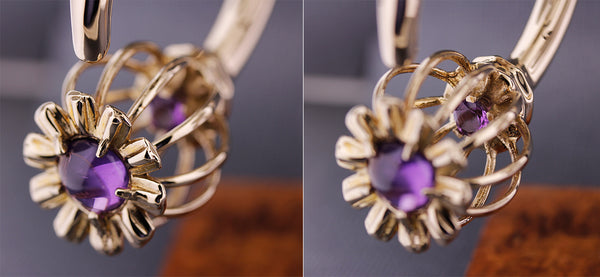
There are two stone settings in Somnia, the "eye" at the front, and the "heart" at the center of the cage. Both are prong based and have 5 prongs to compliment the 10 ribs of the cage. The stone at the center of the cage is by far the more challenging of the two to set, and it happens first.
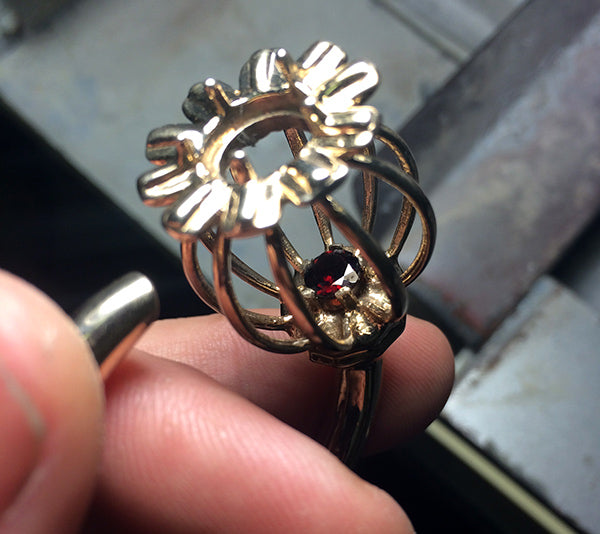
The cage itself is about 22mm or 7/8" in diameter, and the space between the ribs at the widest point is ~5mm, so there is very little room to work. Setting the 6mm facet happens through the hole at the front and through the ribs on the sides. The ribs themselves are fragile and can be bent easily with sideways force, so great care has to be taken to avoid using them as leverage while cutting or bending the prongs. It's a tedious, kind of ridiculous process. I tried to plan as much of it on paper as possible before I had actual casts in my hands to work, but you can never anticipate everything. I ended up making a few small tools to help with this process.
After each prong is cleaned up and moved to the proper position, the individual 6mm (about 1ct) stones I intend to use are measured and test fit. I cut notches into the prongs where I want the stone to sit and push the stone into place, again checking fit. That's what's happening in the photo above. Next the excess material is cut off the tops of the prongs, and they are bent over the stone and given some love to shine them up.
The stone at the front is set last, and thankfully it's a much easier process. The stone is seated in a slightly recessed seat (shown in the above photo). Each prong is notched so it will bend more easily, and any additional length is cut down. They are polished and bent over the stone, and the last step is to do a once over polish on the entire piece.
The result is one of my favorite styles to date, Somnia. By merging my interest in ethnobotany with my interest and experience in body modification, I was able to create something that I think does justice to both. That makes me very happy. I look forward to exploring this idea further, and you can certainly expect more ethnobotany themed pieces to grace our body jewelry collection in the future.
To purchase Somnia ear weights, click here.



